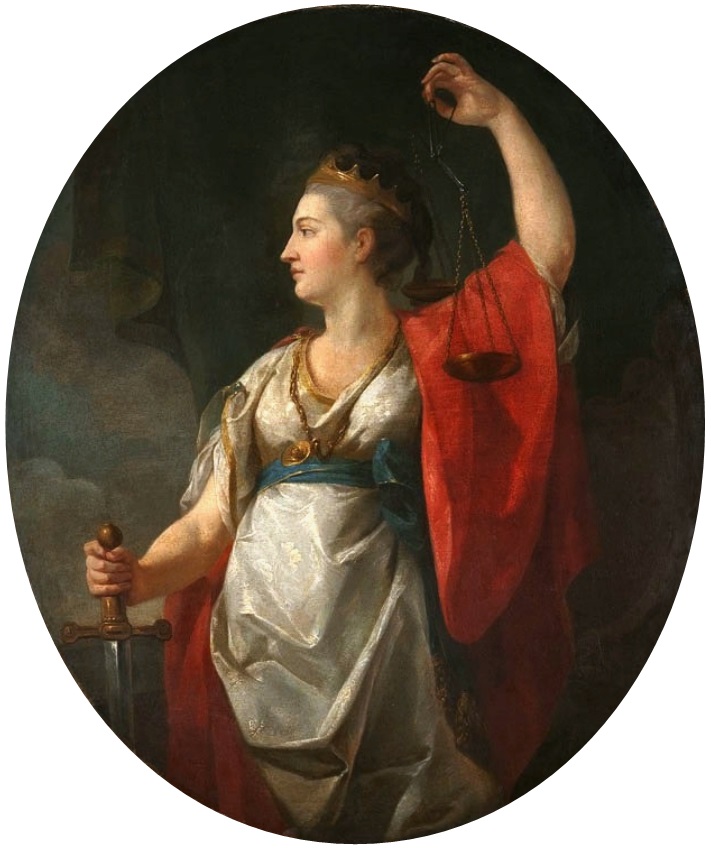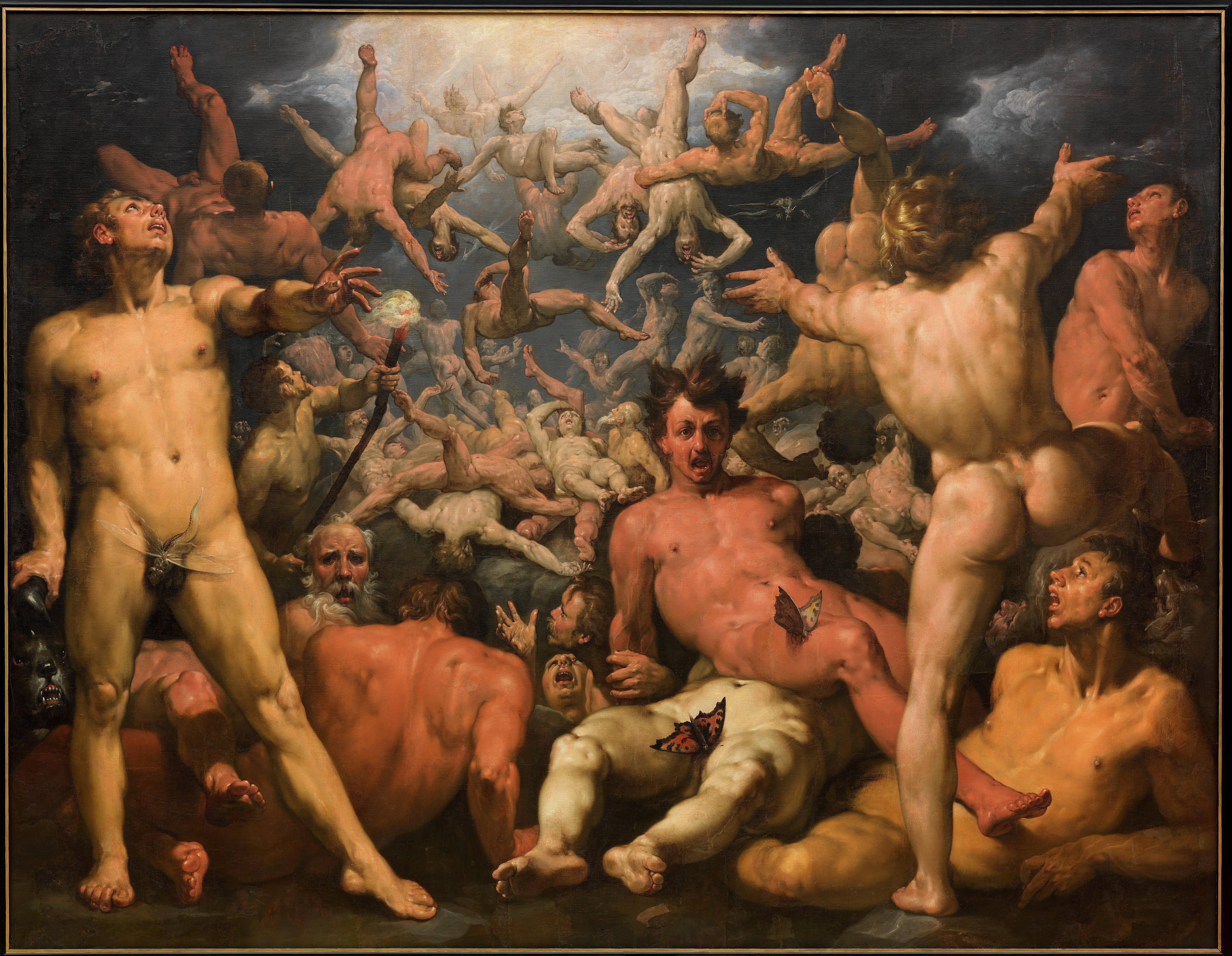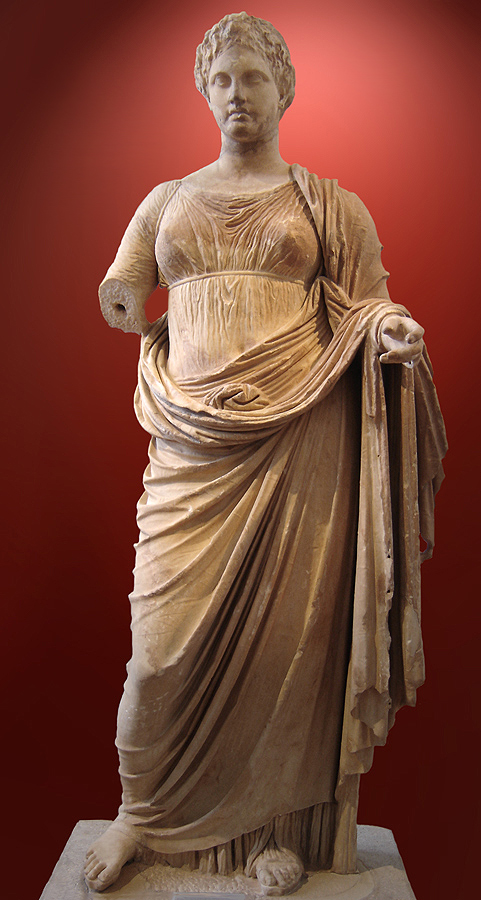|
Themis
In Greek mythology and religion, Themis (; grc, Θέμις, Themis, justice, law, custom) is one of the twelve Titan children of Gaia and Uranus, and the second wife of Zeus. She is the goddess and personification of justice, divine order, fairness, law, and custom, and her symbols include the Scales of Justice. She is also associated with oracles and prophecies, including the Oracle of Delphi. Name ''Themis'' means "divine law" rather than human ordinance, literally "that which is put in place", from the Greek verb ''títhēmi'' ( τίθημι), meaning "to put." To the ancient Greeks she was originally the organizer of the "communal affairs of humans, particularly assemblies." Moses Finley remarked of ''themis'', as the word was used by Homer in the 8th century BCE, to evoke the social order of the 10th- and 9th-century Greek Dark Ages: Finley adds, "There was ''themis''—custom, tradition, folk-ways, ''mores'', whatever we may call it, the enormous power of 'it is ( ... [...More Info...] [...Related Items...] OR: [Wikipedia] [Google] [Baidu] |
Titans
In Greek mythology, the Titans ( grc, οἱ Τῑτᾶνες, ''hoi Tītânes'', , ''ho Tītân'') were the pre-Olympian gods. According to the ''Theogony'' of Hesiod, they were the twelve children of the primordial parents Uranus (Sky) and Gaia (Earth), with six male Titans—Oceanus, Coeus, Crius, Hyperion, Iapetus, and Cronus—and six female Titans, called the Titanides or "Titanesses" (, ''hai Tītānídes'')— Theia, Rhea, Themis, Mnemosyne, Phoebe, and Tethys. Cronus mated with his older sister Rhea, who then bore the first generation of Olympians: the six siblings Zeus, Hades, Poseidon, Hestia, Demeter, and Hera. Certain descendants of the Titans, such as Prometheus, Helios, and Leto, are sometimes also called Titans. The Titans were the former gods: the generation of gods preceding the Olympians. They were overthrown as part of the Greek succession myth, which tells how Cronus seized power from his father Uranus and ruled the cosmos with his fellow Titans bef ... [...More Info...] [...Related Items...] OR: [Wikipedia] [Google] [Baidu] |
Themis (other)
Themis is one of the twelve Titan children of Gaia and Uranus in Greek mythology. Themis may also refer to: Space * 24 Themis, an asteroid in the (main) asteroid belt * THEMIS, a solar telescope located at the Teide Observatory * Themis (hypothetical moon), a spurious tenth moon of Saturn * THEMIS, Time History of Events and Macroscale Interactions during Substorms a constellation of five NASA satellites launched in 2007 * Thermal Emission Imaging System (THEMIS), an instrument on the 2001 ''Mars Odyssey'' orbiter * Europa Thermal Emission Imaging System (E-THEMIS), a version of the THEMIS camera flown on the ''Europa Clipper'' * Themis programme, a European prototype of reusable launch system to fly around 2025 Other * Protein THEMIS, a protein in humans, required for proper maturation of T cells * ''Themis'' (alga), a genus of red algae in the family Bangiaceae * Themis (solar power plant), a former solar power plant in Targassonne, France * Themis, a local nymph of the Ar ... [...More Info...] [...Related Items...] OR: [Wikipedia] [Google] [Baidu] |
Themis Of Rhamnous
The Themis of Rhamnous is a statue found in 1890 in Rhamnous, identified as the goddess Themis and dated to around 300 BCE on the basis of a dedicatory inscription on its base. It is displayed in the National Archaeological Museum of Athens. Description The statue, tall, is carved of Pentelic marble. Her standing figure is dressed in a sleeved chiton caught by a zone under the bodice, wrapped in a himation whose ends are draped over her outstretched left forearm. The head is carved separately, the hair upswept and carved sketchily. Her weight is borne on the left leg, with the right knee brought forward and the heel lifted. The right forearm is missing, and would have held an offering bowl; the left hand would have held a set of scales. One curiosity is the knot of fabric resting on the himation; this detail has no clear relationship to the rest of the drapery. The figure stands on a low, square base with a molding at both the top and the bottom. On its front surface is a de ... [...More Info...] [...Related Items...] OR: [Wikipedia] [Google] [Baidu] |
Zeus
Zeus or , , ; grc, Δῐός, ''Diós'', label=genitive Boeotian Aeolic and Laconian grc-dor, Δεύς, Deús ; grc, Δέος, ''Déos'', label=genitive el, Δίας, ''Días'' () is the sky and thunder god in ancient Greek religion, who rules as king of the gods on Mount Olympus. His name is cognate with the first element of his Roman equivalent Jupiter.''Larousse Desk Reference Encyclopedia'', The Book People, Haydock, 1995, p. 215. His mythology and powers are similar, though not identical, to those of Indo-European deities such as Jupiter, Perkūnas, Perun, Indra, Dyaus, and Zojz. Entry: "Dyaus" Zeus is the child of Cronus and Rhea, the youngest of his siblings to be born, though sometimes reckoned the eldest as the others required disgorging from Cronus's stomach. In most traditions, he is married to Hera, by whom he is usually said to have fathered Ares, Eileithyia, Hebe, and Hephaestus. At the oracle of Dodona, his consort was said to be Dione, by whom ... [...More Info...] [...Related Items...] OR: [Wikipedia] [Google] [Baidu] |
Scales Of Justice (symbol)
Lady Justice ( la, Iustitia) is an allegorical personification of the moral force in judicial systems. Her attributes are scales, a sword and sometimes a blindfold. She often appears as a pair with Prudentia. Lady Justice originates from the personification of Justice in Ancient Roman art known as ''Iustitia'' or ''Justitia'', who is equivalent to the Greek goddess Dike. The goddess Justitia The origin of Lady Justice was Justitia (or Iustitia), the goddess of Justice within Roman mythology. Justitia was introduced by emperor Augustus, and was thus not a very old deity in the Roman pantheon. Justice was one of the virtues celebrated by emperor Augustus in his ''clipeus virtutis'', and a temple of Iustitia was established in Rome by emperor Tiberius. Iustitia became a symbol for the virtue of justice with which every emperor wished to associate his regime; emperor Vespasian minted coins with the image of the goddess seated on a throne called ''Iustitia Augusta'', and many empe ... [...More Info...] [...Related Items...] OR: [Wikipedia] [Google] [Baidu] |
Phoebe (Titaness)
In ancient Greek religion and mythology, Phoebe ( ; grc, Φοίβη, Phoíbē, associated with ''phoîbos'', "shining") was one of the first generation of Titans, who were one set of sons and daughters of Uranus and Gaia.Hesiod, ''Theogony'116-138 She was the grandmother of the sun god Apollo, the moon goddess Artemis, and the witchcraft goddess Hecate. According to myth, she was the original owner of the Oracle of Delphi before gifting it to her grandson Apollo. Her name, meaning "bright", was also given to a number of lunar goddesses like Artemis and later the Roman goddesses Luna and Diana, but Phoebe herself was not actively treated as a moon goddess on her own right in ancient mythology. Etymology Greek , feminine form of ' means "pure, bright".''A Greek-English Lexicon'' s.vφοῖβος Another meaning is "prophet", a reference to her role in myth. Used for water and fire both, it can thus be explained as generally meaning "pure", "clear", or "bright". Family Pho ... [...More Info...] [...Related Items...] OR: [Wikipedia] [Google] [Baidu] |
Tethys (mythology)
In Greek mythology, Tethys (; grc, Τηθύς, Tēthýs) was a Titan daughter of Uranus and Gaia, a sister and wife of the Titan Oceanus, and the mother of the river gods and the Oceanids. Although Tethys had no active role in Greek mythology and no established cults, she was depicted in mosaics decorating baths, pools, and triclinia in the Greek East, particularly in Antioch and its suburbs, either alone or with Oceanus. Genealogy Tethys was one of the Titan offspring of Uranus (Sky) and Gaia (Earth). Hesiod lists her Titan siblings as Oceanus, Coeus, Crius, Hyperion, Iapetus, Theia, Rhea, Themis, Mnemosyne, Phoebe, and Cronus. Tethys married her brother Oceanus, an enormous river encircling the world, and was by him the mother of numerous sons (the river gods) and numerous daughters (the Oceanids). According to Hesiod, there were three thousand (i.e. innumerable) river gods. These included Achelous, the god of the Achelous River, the largest river in Greece, who ... [...More Info...] [...Related Items...] OR: [Wikipedia] [Google] [Baidu] |
Gaia (mythology)
In Greek mythology, Gaia (; from Ancient Greek , a poetical form of , 'land' or 'earth'),, , . also spelled Gaea , is the personification of the Earth and one of the Greek primordial deities. Gaia is the ancestral mother—sometimes parthenogenic—of all life. She is the mother of Uranus (the sky), from whose sexual union she bore the Titans (themselves parents of many of the Olympian gods), the Cyclopes, and the Giants; as well as of Pontus (the sea), from whose union she bore the primordial sea gods. Her equivalent in the Roman pantheon was Terra.''Larousse Desk Reference Encyclopedia'', The Book People, Haydock, 1995, p. 215. Etymology The Greek name Γαῖα (''Gaia'' or ) is a mostly epic, collateral form of Attic (''Gē'' ), and Doric (''Ga'' ), perhaps identical to (''Da'' ), both meaning "Earth". The word is of uncertain origin. Beekes suggested a Pre-Greek origin. Robert S. P. Beekes, ''Etymological Dictionary of Greek'', Brill, 2009, pp. 269–270 ... [...More Info...] [...Related Items...] OR: [Wikipedia] [Google] [Baidu] |
Coeus
In Greek mythology, Coeus (; grc, Κοῖος, ''Koios'', "query, questioning" or "intelligence"), also called Polus, was one of the Titans, one of the three groups of children born to Uranus (Sky) and Gaia (Earth). Mythology Coeus was an obscure figure, and like most of the Titans he played no active part in Greek mythology—he appears only in lists of Titans—but was primarily important for his descendants. With his sister, "shining" Phoebe, Coeus fathered two daughters, Leto and Asteria. Leto copulated with Zeus (the son of fellow Titans Cronus and Rhea) and bore Artemis and Apollo. Asteria became the mother of Hecate by Perses (son of fellow Titan Crius and half-sister Eurybia). Given that Phoebe symbolized prophetic wisdom just as Coeus represented rational intelligence, the couple may have possibly functioned together as the primal font of all knowledge in the cosmos. Along with the other Titans, Coeus was overthrown by Zeus and the other Olympians in the Titano ... [...More Info...] [...Related Items...] OR: [Wikipedia] [Google] [Baidu] |
Theia
In Greek mythology, Theia (; grc, Θεία, Theía, divine, also rendered Thea or Thia), also called Euryphaessa ( grc, Εὐρυφάεσσα) "wide-shining", is one of the twelve Titans, the children of the earth goddess Gaia and the sky god Uranus. She is the Greek goddess of sight and vision, and by extension the goddess who endowed gold, silver and gems with their brilliance and intrinsic value. Her brother-consort is Hyperion, a Titan and god of the sun, and together they are the parents of Helios (the Sun), Selene (the Moon), and Eos (the Dawn). She seems to be the same with Aethra, the consort of Hyperion and mother of his children in some accounts. Like her husband, Theia features scarcely in myth, being mostly important for the children she bore, though she appears in some texts and rare traditions. Etymology The name ''Theia'' alone means simply "goddess" or "divine"; ''Theia Euryphaessa'' () brings overtones of extent (, ''eurys'', "wide", root: ) and brigh ... [...More Info...] [...Related Items...] OR: [Wikipedia] [Google] [Baidu] |
Oceanus
In Greek mythology, Oceanus (; grc-gre, , Ancient Greek pronunciation: , also Ὠγενός , Ὤγενος , or Ὠγήν ) was a Titans (mythology), Titan son of Uranus (mythology), Uranus and Gaia, the husband of his sister the Titan Tethys (mythology), Tethys, and the father of the Potamoi, river gods and the Oceanids, as well as being the great river which encircled the entire world. Etymology According to Martin Litchfield West, M. L. West, the etymology of Oceanus is "obscure" and "cannot be explained from Greek". The use by Pherecydes of Syros of the form "Ogenos" (''Ὠγενός'') for the name lends support for the name being a loanword. However, according to West, no "very convincing" foreign models have been found. A Semitic derivation has been suggested by several scholars, while Robert S. P. Beekes, R. S. P. Beekes has suggested a loanword from the Aegean Pre-Greek substrate, Pre-Greek non-Indo-European languages, Indo-European Stratum (linguistics), substrat ... [...More Info...] [...Related Items...] OR: [Wikipedia] [Google] [Baidu] |
Iapetus (mythology)
In Greek mythology, Iapetus (; ; grc, Ἰαπετός, Iapetós), also Japetus, is a Titan, the son of Uranus and Gaia and father of Atlas, Prometheus, Epimetheus, and Menoetius. He was also called the father of Buphagus and Anchiale in other sources. Iapetus was linked to Japheth (יֶפֶת) one of the sons of Noah and a progenitor of mankind in biblical accounts. The practice by early historians and biblical scholars of identifying various historical nations and ethnic groups as descendants of Japheth, together with the similarity of their names, led to a fusion of their identities, from the early modern period to the present. Mythology Iapetus ("the Piercer") is the one Titan mentioned by Homer in the ''Iliad'' as being in Tartarus with Cronus. He is a brother of Cronus, who ruled the world during the Golden Age but is now locked up in Tartarus along with Iapetus, where neither breeze nor light of the sun reaches them. Iapetus' wife is usually described as a daughte ... [...More Info...] [...Related Items...] OR: [Wikipedia] [Google] [Baidu] |




